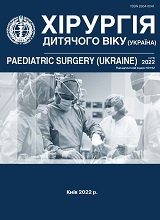X-ray diagnosis of fractures of the condylar process of the lower jaw in children
DOI:
https://doi.org/10.15574/PS.2022.76.36Keywords:
fracture, condylar process, lower jaw, childrenAbstract
Mandibular fractures are one of the most common and complex types of traumatic injuries of the maxillofacial region in children and account for 18-66% of the total number of facial fractures. Among which, fractures in the area of the condylar processes of the mandible (CP) occur in 25-40% of cases.
Purpose - to reveal the radiological features of CP fractures in children and to determine the most informative diagnostic methods.
Materials and methods. A retrospective analysis of 25 case histories of children with traumatic fractures of the VGNP aged 4 to 18 years was carried out. The analysis of case histories was carried out according to the developed survey map. Under our supervision there were 25 children with traumatic fractures of CP. The age of children ranged from 4 to 17 years, the average age was 10.04 years (±4.09). All children were divided into groups, among which the largest group consisted of children aged 7-12 years - 52% (n=13) of children.
Results. Unilateral fractures were detected in 84% (n=21) and bilateral in 16% (n=4) of children, among them with displacement in 92% (n=23). CP fractures in the region of the head were diagnosed in 36% (n=9), the base in 32% (n=8), the neck in 28% (n=7) and the combination of the base and neck in 4% (n=1).
Conclusions. The only method that allows obtaining maximum information about various injuries in the bone structures of the joint is CT and spiral 3D-CT. The latter, in turn, allows you to detail any changes in the bone elements of the temporo-mandibular joint for diagnosis, selection and planning of individual treatment tactics, which reduces the time of surgery and the child's stay under anesthesia.
The research was carried out in accordance with the principles of the Helsinki Declaration. The study protocol was approved by the Local Ethics Committee of the participating institution. The informed consent of the patient was obtained for conducting the studies.
No conflict of interests was declared by the authors.
References
Cazzolla A, Montaruli G, Testa N, Favia G, Lacaita M, Lo Muzio L, Ciavarella D. (2018). Non-surgical Treatment of Condylar Fracture in an 11-Year-Old Patient: a Case Report. J Oral Maxillofac Res. 29; 9 (2): e5. https://doi.org/10.5037/jomr.2018.9205; PMid:30116517 PMCid:PMC6090249
Elarabi M, Bataineh A. (2018). Changing pattern and etiology of maxillofacial fractures during the civil uprising in Western Libya. Med Oral Patol Oral Cir Bucal. 1; 23 (2): 248-255. https://doi.org/10.4317/medoral.22268; PMid:29476683 PMCid:PMC5911362
Kannari L, Marttila E, Toivari M, Thorén H, Snäll J. (2020). Paediatric mandibular fracture-a diagnostic challenge? Int J Oral Maxillofac Surg. 49 (11): 1439-1444. https://doi.org/10.1016/j.ijom.2020.06.008; PMid:32680807
McGoldrick D, Parmar P, Williams R, Monaghan A, McMillan K. (2019). Management of Pediatric Condyle Fractures. J Craniofac Surg. 30 (7): 2045-2047. https://doi.org/10.1097/SCS.0000000000005787; PMid:31369504
Mukhopadhyay S. (2018). A retrospective study of mandibular fractures in children. J Korean Assoc Oral Maxillofac Surg. 44 (6): 269-274. https://doi.org/10.5125/jkaoms.2018.44.6.269; PMid:30637240 PMCid:PMC6327018
Nezam S, Kumar A, Shukla JN, Khan SA. (2018). Management of mandibular fracture in pediatric patient. Natl J Maxillofac Surg. 9 (1): 106-109. https://doi.org/10.4103/njms.NJMS_54_17; PMid:29937672 PMCid:PMC5996639
Rozeboom A, Dubois L, Bos R. (2017). Closed treatment of unilateral mandibular condyle fractures in adults: a systematic review. Int J Oral Maxillofac Surg. 46: 456-464. https://doi.org/10.1016/j.ijom.2016.11.009; PMid:27955799
Stähli C, Eliades T, Papageorgiou S. (2021). Functional appliance treatment for mandibular fractures: A systematic review with meta-analyses. J Oral Rehabil. 48 (8): 945-954. https://doi.org/10.1111/joor.13178; PMid:33963591 PMCid:PMC8362118
Vanpoecke J, Dubron K, Politis C. (2020). Condylar Fractures: An Argument for Conservative Treatment. Craniomaxillofac Trauma Reconstr. 13 (1): 23-31. https://doi.org/10.1177/1943387520902881; PMid:32642028 PMCid:PMC7311847
Downloads
Published
Issue
Section
License
Copyright (c) 2022 Paediatric Surgery (Ukraine)

This work is licensed under a Creative Commons Attribution-NonCommercial 4.0 International License.
The policy of the Journal “PAEDIATRIC SURGERY. UKRAINE” is compatible with the vast majority of funders' of open access and self-archiving policies. The journal provides immediate open access route being convinced that everyone – not only scientists - can benefit from research results, and publishes articles exclusively under open access distribution, with a Creative Commons Attribution-Noncommercial 4.0 international license(СС BY-NC).
Authors transfer the copyright to the Journal “PAEDIATRIC SURGERY.UKRAINE” when the manuscript is accepted for publication. Authors declare that this manuscript has not been published nor is under simultaneous consideration for publication elsewhere. After publication, the articles become freely available on-line to the public.
Readers have the right to use, distribute, and reproduce articles in any medium, provided the articles and the journal are properly cited.
The use of published materials for commercial purposes is strongly prohibited.

